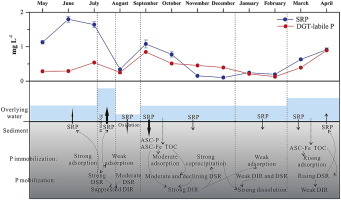当前位置:
X-MOL 学术
›
Water Res.
›
论文详情
Our official English website, www.x-mol.net, welcomes your
feedback! (Note: you will need to create a separate account there.)
Cyclical patterns and (im)mobilization mechanisms of phosphorus in sediments from a small creek estuary: Evidence from in situ monthly sampling and indoor experiments.
Water Research ( IF 11.4 ) Pub Date : 2020-01-07 , DOI: 10.1016/j.watres.2020.115479 Feng Pan 1 , Zhanrong Guo 1 , Yu Cai 1 , Yuyao Fu 1 , Jinye Wu 1 , Bo Wang 1 , Huatai Liu 2 , Aiguo Gao 3
Water Research ( IF 11.4 ) Pub Date : 2020-01-07 , DOI: 10.1016/j.watres.2020.115479 Feng Pan 1 , Zhanrong Guo 1 , Yu Cai 1 , Yuyao Fu 1 , Jinye Wu 1 , Bo Wang 1 , Huatai Liu 2 , Aiguo Gao 3
Affiliation

|
Internal phosphorus (P) mobility is crucially important to overlying water ecosystems, while its spatiotemporal variations and mechanisms remain to be studied, especially in dynamic estuarine sediments. In this study, in situ monthly field sampling and indoor experiments were combined to measure the soluble reactive P (SRP), soluble Fe and diffusive gradients in thin films (DGT)-labile P/S in the overlying water, sediment and porewater in the Jiuxi River Estuary by employing high-resolution dialysis (HR-Peeper), the DGT technique and a MicroRhizon sampler. The consistent tendency between DGT-labile S and P in most seasons indicates that P mobilization was dominated by intense dissimilatory sulfate reduction (DSR), causing high SRP concentrations and active exchange with the overlying water. The circannual cyclical pattern of P is summarized, where in addition to temperature, monthly changes in runoff and tidal range are crucial external factors to control long-term P cycling via changed redox environments and terrigenous materials inputs. The mobile P, Fe and S present higher values during flood tides and lower values during ebb tides in tidal simulation experiments, demonstrating that the short-term cycling of P, Fe and S in intertidal surface sediments is highly redox-sensitive and controlled by tidal processes. The results also reveal that DSR greatly facilitates P mobility and release, while sediment oxidation and the induced enhancement in DIR and Fe cycling can effectively control P immobilization.
中文翻译:

一条小河口河口沉积物中磷的循环模式和(不)迁移机理:来自每月原位采样和室内实验的证据。
内部磷迁移对上层水生态系统至关重要,而其时空变化和机理尚待研究,尤其是在动态河口沉积物中。在这项研究中,结合原位月度野外采样和室内实验,测量了上覆水,沉积物和孔隙水中不稳定的P / S薄膜中的可溶性反应性P(SRP),可溶性Fe和扩散梯度。通过高分辨率透析(HR-Peeper),DGT技术和MicroRhizon采样器,在九溪河口。在大多数季节中,DGT不稳定的S和P之间的一致趋势表明,磷的迁移主要由强烈的异化硫酸盐还原(DSR)引起,从而导致高SRP浓度和与上层水的主动交换。总结了P的周期性变化规律,除温度外,径流和潮汐量每月的变化是通过变化的氧化还原环境和陆源物质输入来控制长期磷循环的关键外部因素。在潮汐模拟实验中,流动的P,Fe和S在潮汐时呈现较高的值,而在退潮时呈现较低的值,表明潮汐表层沉积物中P,Fe和S的短期循环高度氧化还原敏感,并受潮汐控制。流程。结果还表明,DSR极大地促进了P的迁移和释放,而沉积物氧化以及DIR和Fe循环的诱导增强可以有效地控制P的固定。径流和潮汐量每月的变化是通过改变氧化还原环境和陆源物质输入来控制长期磷循环的关键外部因素。在潮汐模拟实验中,流动的P,Fe和S在潮汐时呈现较高的值,而在退潮时则呈现较低的值,这表明潮汐表层沉积物中P,Fe和S的短期循环对氧化还原高度敏感,并受潮汐控制。流程。结果还表明,DSR极大地促进了P的迁移和释放,而沉积物的氧化以及DIR和Fe循环的诱导增强可以有效地控制P的固定。径流和潮汐量每月的变化是通过改变氧化还原环境和陆源物质输入来控制长期磷循环的关键外部因素。在潮汐模拟实验中,流动的P,Fe和S在潮汐时呈现较高的值,而在退潮时则呈现较低的值,这表明潮汐表层沉积物中P,Fe和S的短期循环对氧化还原高度敏感,并受潮汐控制。流程。结果还表明,DSR极大地促进了P的迁移和释放,而沉积物的氧化以及DIR和Fe循环的诱导增强可以有效地控制P的固定。潮间表面沉积物中的铁和硫对氧化还原非常敏感,并受潮汐过程控制。结果还表明,DSR极大地促进了P的迁移和释放,而沉积物的氧化以及DIR和Fe循环的诱导增强可以有效地控制P的固定。潮间表面沉积物中的铁和硫对氧化还原非常敏感,并受潮汐过程控制。结果还表明,DSR极大地促进了P的迁移和释放,而沉积物的氧化以及DIR和Fe循环的诱导增强可以有效地控制P的固定。
更新日期:2020-01-07
中文翻译:

一条小河口河口沉积物中磷的循环模式和(不)迁移机理:来自每月原位采样和室内实验的证据。
内部磷迁移对上层水生态系统至关重要,而其时空变化和机理尚待研究,尤其是在动态河口沉积物中。在这项研究中,结合原位月度野外采样和室内实验,测量了上覆水,沉积物和孔隙水中不稳定的P / S薄膜中的可溶性反应性P(SRP),可溶性Fe和扩散梯度。通过高分辨率透析(HR-Peeper),DGT技术和MicroRhizon采样器,在九溪河口。在大多数季节中,DGT不稳定的S和P之间的一致趋势表明,磷的迁移主要由强烈的异化硫酸盐还原(DSR)引起,从而导致高SRP浓度和与上层水的主动交换。总结了P的周期性变化规律,除温度外,径流和潮汐量每月的变化是通过变化的氧化还原环境和陆源物质输入来控制长期磷循环的关键外部因素。在潮汐模拟实验中,流动的P,Fe和S在潮汐时呈现较高的值,而在退潮时呈现较低的值,表明潮汐表层沉积物中P,Fe和S的短期循环高度氧化还原敏感,并受潮汐控制。流程。结果还表明,DSR极大地促进了P的迁移和释放,而沉积物氧化以及DIR和Fe循环的诱导增强可以有效地控制P的固定。径流和潮汐量每月的变化是通过改变氧化还原环境和陆源物质输入来控制长期磷循环的关键外部因素。在潮汐模拟实验中,流动的P,Fe和S在潮汐时呈现较高的值,而在退潮时则呈现较低的值,这表明潮汐表层沉积物中P,Fe和S的短期循环对氧化还原高度敏感,并受潮汐控制。流程。结果还表明,DSR极大地促进了P的迁移和释放,而沉积物的氧化以及DIR和Fe循环的诱导增强可以有效地控制P的固定。径流和潮汐量每月的变化是通过改变氧化还原环境和陆源物质输入来控制长期磷循环的关键外部因素。在潮汐模拟实验中,流动的P,Fe和S在潮汐时呈现较高的值,而在退潮时则呈现较低的值,这表明潮汐表层沉积物中P,Fe和S的短期循环对氧化还原高度敏感,并受潮汐控制。流程。结果还表明,DSR极大地促进了P的迁移和释放,而沉积物的氧化以及DIR和Fe循环的诱导增强可以有效地控制P的固定。潮间表面沉积物中的铁和硫对氧化还原非常敏感,并受潮汐过程控制。结果还表明,DSR极大地促进了P的迁移和释放,而沉积物的氧化以及DIR和Fe循环的诱导增强可以有效地控制P的固定。潮间表面沉积物中的铁和硫对氧化还原非常敏感,并受潮汐过程控制。结果还表明,DSR极大地促进了P的迁移和释放,而沉积物的氧化以及DIR和Fe循环的诱导增强可以有效地控制P的固定。











































 京公网安备 11010802027423号
京公网安备 11010802027423号